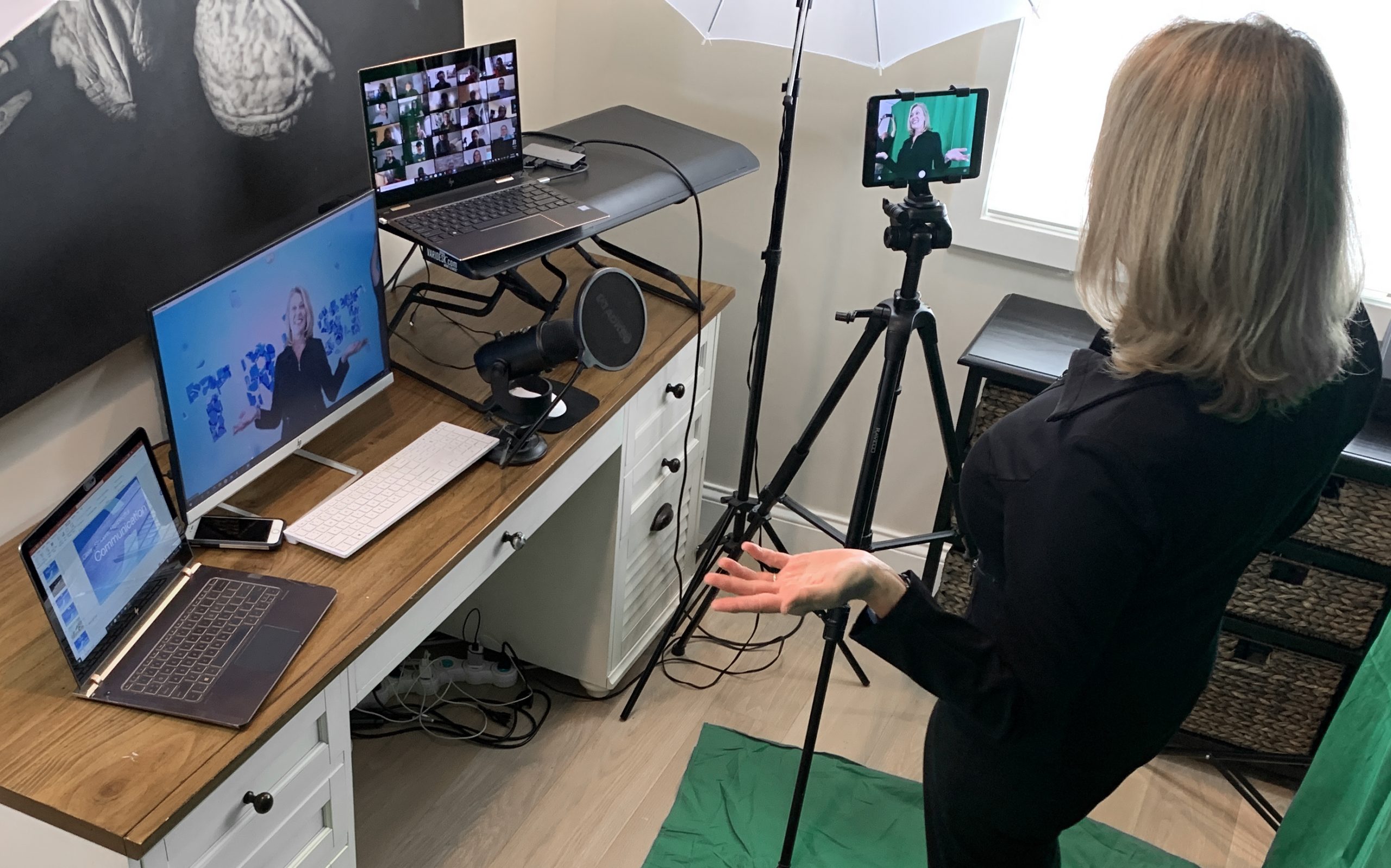
July 29, 2020
Vol. 18, Issue 3
It looks like Live Events won’t be possible for a while –
So what do you do now? What if you have never conducted a virtual event?
The virtual world is literally a new space. It’s fluid and static at the same time. In the virtual world, you’re in your place. I’m in mine. Presenters, speakers, panelists, are each in their places. Each audience member is in their own place. But we’re all in one “space” online.
This is the opposite of what’s happening when we meet together all in one place such as an auditorium or a conference room. What was the meeting place is now a common space on the Internet — the platform you’re using to broadcast your event.
That’s why it’s important if you haven’t tried a large gathering on screen, to rethink your event totally from the ground up.
First the good news — Here are ten things you won’t have to deal with, or pay for in this new space!
- Cost of food and beverage
- Serving the food and beverage
- Individual meal choices – Vegan, gluten-free, peanut allergies, etc.
- Cost of the venue
- HVAC – Temperature of the room
- Insurance
- Arriving at the venue before dawn to organize registration and deal with long registration lines
- Volunteers – both recruiting them and organizing them at the event
- Signage
- Table decor/centerpiece
Feel better? Then let’s get down to planning: What do you do first, and then what’s next?
Before You Start, Ask a Lot of Questions
First thing in designing your virtual event: Ask a lot of questions. You can’t assume that everything but the space will be the same.
Start with the main question: What is the purpose of this event? Is it education, celebration, team building, motivation, inspiration, information, or entertainment? Do you want to raise funds? Attract volunteers? Increase your institution’s presence in the community? Write out the results that you want to achieve,
Then re-frame your approach to fit your purpose:
- Put yourself in the shoes of the attendees.
- Get agreement from everyone in your planning group that they are willing to re-think the event through this new online lens.
- Think more like a broadcaster than an event planner.
Event Elements
What were all the elements of your original live event? In this new space, which elements can you keep, and which ones can you discard? What might you add to the mix to bring life to it or to attract a larger audience?
- Registration?
- Fee or no fee?
- Emcee or host?
- Increase audience interest and engagement?
- New channels of publicity that you could utilize?
- Opening or closing statement from an executive?
- Physician presentations or panels?
- Speaker? Q & A?
- Survivor testimonials?
- Fundraising?
- Raffle?
- Silent Auction?
- CEU’s?
- Sponsors? Sponsor expectations?
- Entertainment?
- Pre-recorded or video segments?
- Audience participation?
The Question of “The Meal”
One of the questions that may come up is the issue of the meal. Many of our cancer survivor and other events revolved around a luncheon or a dinner.
If a meal was included in your original live event, how important was it to the overall event and achieving its results, and how important would it be to the success of your virtual experience? The first thing we’ve heard from many event planners, is: “Oh good, no F&B!” — translates to cost savings!
Others think that providing some kind of take-out might be an option, but they may quickly find out that ordering food for individuals is not as simple as it seems on the surface. Some have solved the meal dilemma by providing gift cards to local restaurants, and some have sent food-oriented gift baskets to their guests. Others have dispensed with the meal entirely. Only you can gauge the importance (or not) of providing a meal as part of your new virtual format.
How TECH SAVVY Is Your Audience?
You cannot take your attendees’ digital savvy (or lack thereof) for granted. Some older audience members are not necessarily familiar with platforms like Zoom. Some are even resistant. You may want to send out pre-event instructions (which our Speak Well Being Group can provide), or even a little video on how to navigate Zoom (or another platform that you may choose). I’ve seen plenty of people challenged by it, simple as it is, especially the first time they participate.
On the other hand, if you’re presenting a webinar, technical knowledge is not as much of an issue because audience participation is limited in a webinar format. Still, you want people to feel comfortable accessing the platform.
Keeping the Audience Engaged
Here is where your creativity can shine. Obviously, social interaction is different in a virtual environment than in a live one. That means you can provide different opportunities for engagement, some really innovative.
While people are watching a keynote individually, for example, the speaker can get their inputs via live polling. This engages people — seeing their answers and how their opinions relate to the rest of the group. Live Q & A is also an option. The Chat can be used to collect brief comments or replies or asking a quick question, or just to create energy by typing in exclamation marks for applause.
Breakout sessions in a virtual presentation are easy and effective. They allow people to converse with other participants in small groups to reach personal decisions or to deepen their understanding of an issue. In Zoom, breakouts form instantly – no need to walk to a meeting room – and participants return to the full meeting instantly. The pace of the meeting remains fast.
You might also facilitate a Happy Hour — maybe even sending the actual provisions.
You can encourage social media activity before, during, and after the event to expand the range of attendance and after-effects with an event hash-tag, and opportunities to post pictures and share takeaways.
Who Will Run the Show?
Qualities and Advantages of a Knowledgeable Virtual Emcee
You may have had an emcee for your live event, but in the virtual environment, you’ll want to make sure your emcee or host is not only personable and agile, but also tech savvy with the platform you’re using.
Here’s where it’s important to think like a broadcaster. Think of the audiences at the sporting events you watch on television. There are people in the stands at the live event, and there are people watching from home. The broadcaster/host/reporter provides the bridge, reporting on the live event to the audiences at home. And between innings, quarters, or timeouts, there is entertainment (or commercials) to keep the spectators (audience) engaged.
A virtual event emcee will introduce your speakers and keep the moving parts moving, while also connecting your participants with the speakers and creating engagement. An emcee will hold your event together, set the tone for the community’s participation and interaction, and be the guiding light for how the event elements flow.
A professional virtual emcee will know the platform: how to engage with the speaker and the audience, mute and unmute speakers, follow the chat entries, divide the audience into small groups and bring them back on time, facilitate any sharing from the groups’ discussions, and make the best use of the features of the particular platform you choose.
New Issues to Tackle:
- Scale – watch out for growth. Attendance may increase; you may start reaching people you might not otherwise reach – people not physically or financially able to attend in person or who are geographically distant.
- Live speakers and interaction vs. a pre-recorded program that is available On Demand. Think it through:
- If On Demand, how long will On Demand Sessions be available after the event?
- Will you charge fees for the On Demand program while it’s available?
- Time Zones (important if the event is live)
- Checking out and hiring a Virtual Host who is tech savvy and personable to run the show
- Audience Participation
- Q & A
- Small Group Discussions
- Overall Event Length
- Session Length for each session or segment
- Sponsor ROI — product placement/video ads
- Attendee Networking — creating a sense of community
So yes, there are a lot of considerations in taking your formerly live event virtual, but the more thorough you are in your preparations, the less likely you are to be blindsided by surprises and the more rewarding you can make it for your participants. Think of it as a new adventure. You don’t have to re-invent the wheel if you work with people who know the ropes.
At the Speak Well Being Group, we’ve been holding Zoom meetings with our speakers for the last few months to share knowledge. At each meeting, our speakers have reported on their new online experiences and on innovative meeting designs. As a result we have pooled the growing experience of these talented people, and compiled the pointers that you have just read – and many more. That means that we can offer you support in creating your next event from a treasure house of resources and experience.
This teamwork and open sharing mean that the Speak Well Being Group can help you plan and execute a successful event – even on your first venture into the game. Go to our Virtual Resources page to check out some of the ways we can support you. Or give me a call at 503-699-5031.
Next issue will feature Things to Consider When Selecting a Virtual Keynote Speaker.
Until next time, take care of yourself for your well being and those you love. And, for your well being and those you love, WEAR A MASK when you’re out and about.
Barbara
 The Speak Well Being Group is a specialized speakers bureau, focusing on speakers for hospital-sponsored community events, healthcare organizations, nurses, conferences and women’s groups. Our speakers are hand-selected. They are not only experts in their fields, they connect with their audiences while bringing them life-changing information, smiles of recognition and ultimately a sense of well being and hope.
The Speak Well Being Group is a specialized speakers bureau, focusing on speakers for hospital-sponsored community events, healthcare organizations, nurses, conferences and women’s groups. Our speakers are hand-selected. They are not only experts in their fields, they connect with their audiences while bringing them life-changing information, smiles of recognition and ultimately a sense of well being and hope.
Finding the perfect keynote speaker for your special event or conference is my personal passion, not just once, but year after year. It brings me great joy to know that your audience was delighted and moved by the speaker we selected together. I’m committed to making the process easy, pleasant and fun.
